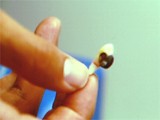

 | |
Zebra Mussel. |
The molluscs settle in large numbers on hard surfaces -- including the shells of their neighbors -- and grow rapidly, disrupting the flow of water pipes and interfering with lake-based industries. In Lake Erie, where the density of zebra mussels can be 20,000 to 100,000 per square meter, they can form layers up to several inches thick on water pipes. They have repeatedly disrupted the local water supply, with millions of dollars spent in pipe-cleaning costs. The pesky molluscs also cling to boat hulls and navigational aids, impeding waterborne transportation. Along with their impact on industry and commerce, zebra mussels dramatically impact the ecological balance of entire lake systems. Present mussel populations are capable of filtering the entire water volume of Lake Erie in one year. While doubling the clarity of thus-affected water systems, the short- and long-term effects of such processes are still in question because the increased penetration of light through the clearer water is changing the distribution of living things in the lakes.
The National Science Foundation has been supporting a variety of scientific efforts to better understand and forecast zebra mussel populations in North America. While zebra mussels have been observed for over 200 years throughout Europe and in areas of the former Soviet Union (FSU), the mussel populations are more stable in those regions due in part to a built-in network of natural enemies, including parasites and predators. In an NSF-funded collaboration, American and FSU scientists examine the zebra mussel in its native geographical range in Russia, Ukraine, Belarus, and in North America. Much of the literature from the FSU regarding zebra mussels has not only posed language problems for American scientists, but until recently, has been nearly inaccessible. Now with more research fodder to compare data across locations, principal investigators Dr. Robert E. Baier, SUNY, Buffalo, and Dr. Daniel P. Molloy, NYS Museum, Albany, and their students and colleagues in Eastern Europe focus on histopathology, parasitology, surface chemical analysis, host-parasite relationships, geographical distribution and other clues to understanding the mollusc which may aid U.S. efforts to control its damaging effects.
The U.S.-Eastern European collaboration and other NSF-funded projects examine the inter-relationship of zebra mussels with their most prominent natural enemies: fish, waterfowl and parasites. Although the vast majority of the European enemies of zebra mussels are not present in North America, ecologically similar species do exist, and zebra mussels are a welcome new target. For example, because of their importance as a prey item to diving ducks, which gobble them eagerly, the presence of zebra mussels in a lake causes dramatic increases in local duck populations, and even affects the timing and routes of their migration. Unfortunately, in long-term studies where predatory birds have caused significant declines in mussel populations, these reductions tend to be temporary, with mussel densities rebounding the next year. Indeed, the same phenomenon holds true with fish predators such as carp or pumpkinseed catfish, or with parasites to which zebra mussels are equally vulnerable.
Current research suggests that study of the mollusc may also hold some benefit to humankind. What is a bust for pipes and boat hulls could be a boon to dentistry. Zebra mussel research, led by Dr. Baier at SUNY Buffalo, may yield a new dental adhesive that would improve the way corrective braces are secured to the surfaces of teeth. Dr. Baier explains: "Because a biofilm is present on the teeth, preventing a firm grip with existing adhesives, today's dental procedures require etching of the teeth prior to brace adhesion. This etching risks future decay. As you can see on the slide (at right), the zebra mussel adheres easily to the tooth without etching." Dr. Baier also sees possibilities of new surgical adhesives, allowing for "no-stitch" surgeries. And since zebra mussels filter so much water so quickly, he and colleagues in the Former Soviet Union are exploring the relationship of zebra mussels and water pollution. International collaborative efforts have once again led to some interesting findings.




